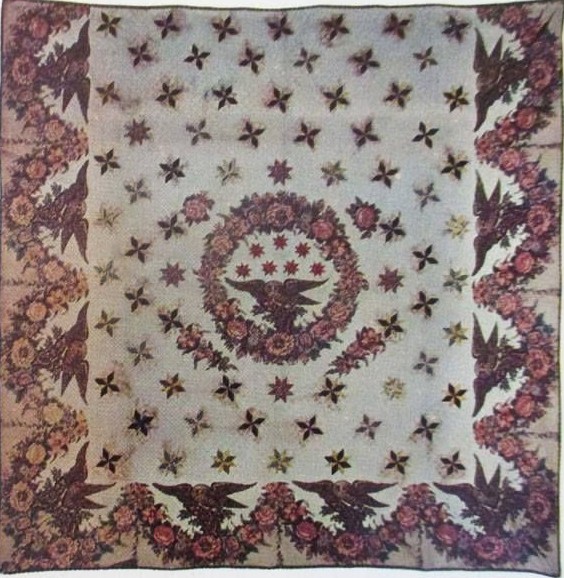
Recently an eagle captured a squirrel off the roof of my house and flew into a neighbor’s tree to eat his breakfast. (You never know where the inspiration for a blog article will appear, especially when concurrently a discussion about eagle fabric on a Facebook page took place…the blog theme was set.) I love eagles and even considered painting one for a quilt after Kay purchased a framed eagle textile for the Poos Collection. Instead, I began tracking eagle fabric in quilts. (Not applique or painted eagles in quilts which seems too numerous to track.) So far, I’ve been tracking four types of 19th century eagle fabric nicknamed: Wreath, floral spray aka festoon, seal, and centennial.

Eagle on a floral spray (festoon) with a maroon background started this journey, with the production of the fabric starting in about 1825 and continuing through 1840. It was later produced in a cream background starting in about 1830 with print production running through 1850. In quilts, the cream background seems to be the most commonly used, at least in the quilts that survived.

The eagle of floral spray is frequently confused with the Eagle in the Wreath. However, the eagle is a different scale with wing spans of different sizes. The floral spray eagle is about 17 inches across, and the eagle in the wreath is more like 12 inches. It is particularly confusing if the quilt artist doesn’t include the full wreath which then looks like a festoon. If you are tracking by a photo, size isn’t always evident. However, the flowers in the two fabrics are different and those will help guide.

The first eagle fabric produced in and for the US market was printed in 1820 and is known as the US Seal fabric. However, it doesn’t match any of the 8 drafts of the US Seal, instead it matches the President Monroe eagle dishes. This style was produced for more than 3 quarters of the 19th century using different methods and different colorways. The early version was block printed on linen. Later versions were cylinder printed, some without the eagle in the center for the European market. Because of the small size, I find it the most difficult to track.

Finally, as part of the 1876 Centennial Exposition a handkerchief was produced with an eagle on it. This eagle is very similar to the eagle seal fabric, but it only has the sepia color, which helps distinguish it. Feel free to email me with any quilt images with eagle fabric in it, as I continue to be on the hunt.




